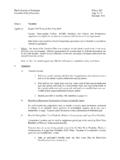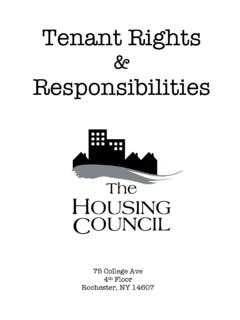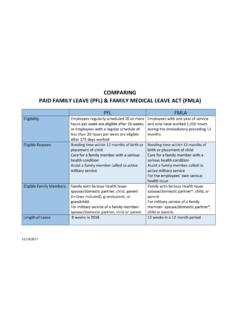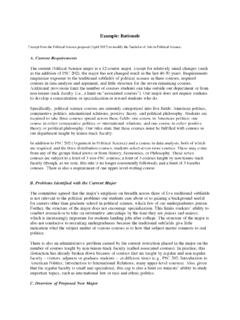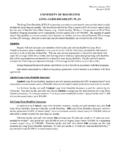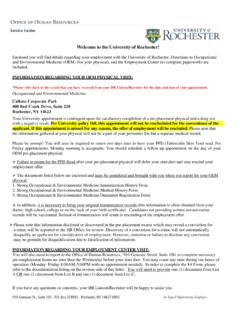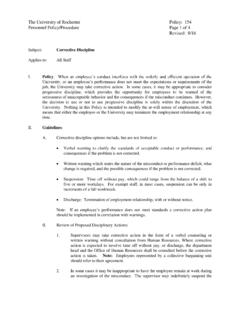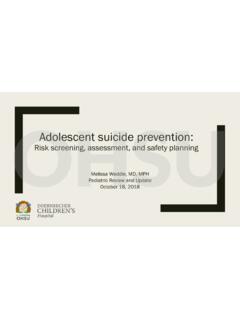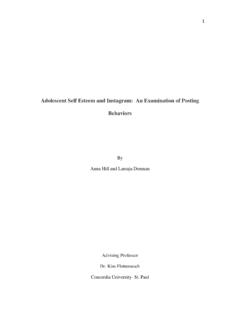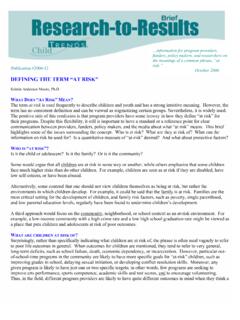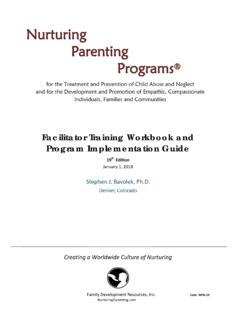Transcription of Bullying in School: Prevalence, Contributing Factors, and ...
1 Bullying in School: Prevalence, Contributing Factors, and Interventions Research Brief | Written by Valerie L. Marsh, PhD October 2018 The work involved in preparing this practitioner brief was supported by a grant by the Moskowitz Family Foundation. The opinions and conclusions reported here, however, are solely the author's. Summary of Findings On Prevalence: 20-29% of students are involved in Bullying (either as a bully, victim, or bully-victim) at least once per year. Bullying has been on the decline in public schools for the past two decades. Bullying occurs throughout the grades, peaking during adolescent middle school years. Forms of Bullying include traditional (physical, verbal, relational) and cyber.
2 Cyberbullying occurs far less frequently than traditional Bullying . There are no measurable differences in Bullying prevalence between suburban, urban, and rural schools. When considering race as a predictor of Bullying and victimization, context must be taken into account, for race alone is not helpful in understanding Bullying s prevalence. At-risk student populations for increased Bullying and victimization include students with disabilities and students who identify as LGBTQ. Peer norms play a significant role in Bullying prevalence. Contributing Factors: Bystanders can have a powerful effect on either stopping or encouraging Bullying , depending on the peer group norm they ascribe to.
3 Teachers can either intensify, encourage, or limit Bullying depending on their approach. Bullying perpetrators and victims share many of the same risk factors ( , negative perceptions of school). Youth who perceive parental support are less likely to bully. A shared belief that normalizes and approves of Bullying is a strong predictor of Bullying . Schools that are perceived as unpleasant, unfair, and unwelcoming increase the likelihood of Bullying . Positive school climates characterized by: a perception of school as a good place to be, trust among students and teachers, and a sense of fairness, belongingness, and safety is negatively associated with Bullying and victimization.
4 Bullying in School: Prevalence, Contributing Factors, and Interventions| 2 The Center for Urban Education Success at the University of Rochester s Warner School of Education | 2 2 Contributing Factors (continued): School climate has a moderating effect on the likelihood that students with high self - esteem will bully. In schools with positive climates, students with high self - esteem are less likely to bully. In schools with negative climate, they are more likely to bully. Bully-victims, who represent the smallest percentage of students involved in Bullying , have the greatest number of risk factors and suffer both internal and external struggles. Recommendations for Bullying Interventions: School-based anti- Bullying programs have a 0%-23% effectiveness rate.
5 An approach to creating a positive school climate shows the most promise in preventing and remediating Bullying . Peer norms must first be modified before any real change in Bullying behaviors can take place. Successful interventions promote pro-social behavior and align with research. Successful interventions are implemented across nested, broader communities of support (school, community, neighborhood, family). Directing efforts on counteracting the more prevalent category of traditional Bullying will in turn lower incidences of cyberbullying. Bullying in School: Prevalence, Students Involved, and Consequences Although the bully-victim conflict is an age-old scenario, researchers only began studying it in school settings 45 years ago.
6 The most agreed upon definition of Bullying includes three criteria: 1) intentionality (desire or goal of inflicting harm, intimidation, and/or humiliation), 2) some repetitiveness, and most importantly, 3) a power imbalance between the socially or physically more prominent bully and the more vulnerable victim (Olweus, 1993; 2013). The power differential can manifest among a variety of factors, such as physical dominance, self -confidence, peer group status, etc. Conversely, conflict between equals (Elliot et al., 2010, p. 534) is not considered Bullying , but rather, general aggression. Another, more recent concept that has emerged in the field of Bullying research is the category of bully-victims, a smaller subset of youth who both perpetrate and experience Bullying (Menesini & Salmivalli, 2017).
7 The forms Bullying can take include: direct aggression ( , name calling, hitting, belittling someone in front of others) or indirect, relational aggression ( , spreading rumors, exclusion from the group, hurting another s reputation) (Juvonen & Graham, 2014). Often occurring in school contexts, which has expanded in recent years to include cyberbullying in the virtual worlds of digital and social media, Bullying takes place throughout the school years, from elementary to high school and has likewise been studied across the grades. And since Bullying is a familiar, if not intimate, school experience for most people, it is sometimes easy or tempting to accept it as a rite of passage or a typical childhood experience, rather than a problem that needs to be addressed.
8 As Olweus (2013) explains, being bullied by peers represents a serious violation of the fundamental rights of the child or youth exposed (p. 770). It is with this understanding of Bullying as a violation of basic human rights that this two-part brief explores the phenomenon (history, prevalence, risk factors, and consequences) in Part I and reviews research-based interventions in Part II. Part I: A Review of Bullying s History, Prevalence, and Consequences in School Settings History As is often the case with social phenomena, a convergence of influences media coverage, societal concern, policy changes, and research attention began to focus on Bullying in the in the 1990 s when it emerged as a problem for school-age children and youth.
9 Concurrently, the World Health Assembly recognized Bullying as an international public health concern in 1996 (Menesini & Salmivalli, 2017). The 1999 Columbine High School shootings in Colorado when two victims of Bullying killed 13 fellow students and one teacher, injuring 21 others on school grounds brought Bullying more fully into the public consciousness (Allen, 2010). It was also during the 90 s that research into Bullying began in the United States, decades after it had started in Sweden and other parts of Europe and Australia. Prior to that time, American researchers focused rather on perpetrators individual factors of aggression, like peer status and likeability, a view that differs from the Scandinavian one that had focused on the effects of aggressive behaviors on victims and the peer dynamics (originally called mobbing ) (Olweus, 1978; 2013).
10 More recently, higher incidences of teen suicide and steady increases in school shootings have sharpened public concern on Bullying and Bullying prevention in schools (Hatzenbuehler, Schwab-Reese, Ranapurwala, Hertz, & Ramirez, 2015; Juvonen & Graham, 2014), resulting in an explosion (Olweus, 2013, p. 774) of research and proliferation (Hatzenbuehler et al., 2015, p. 2) of legislation; 120 bills passed and became anti- Bullying legislation in 49 states Bullying in School: Prevalence, Contributing Factors, and Interventions| 4 The Center for Urban Education Success at the University of Rochester s Warner School of Education | 4 4 between 1999 and 2010. The Department of Education has established and disseminated a framework for states to implement anti- Bullying laws in their schools, issuing a report in 2011 that analyzed the extent to which states laws followed this framework.
